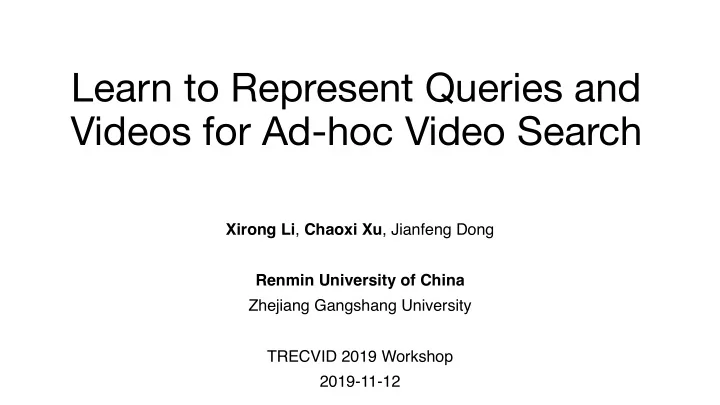

Learn to Represent Queries and Videos for Ad-hoc Video Search Xirong Li , Chaoxi Xu , Jianfeng Dong Renmin University of China Zhejiang Gangshang University TRECVID 2019 Workshop 2019-11-12
Key question in ad-hoc video search How to estimate the relevance of an unlabeled video (clip) with respect to a specific query expressed solely in natural-language text? Three dimensions to explore • Query representation • Video representation • Common space 2
Our approach Based on two deep learning (and concept-free) models W2VV++ [Li et al., ACMMM’19] Dual Encoding [Dong et al., CVPR’19] Focus on both query and video sides Focus on the query side 3
Model 1: W2VV++ Consists of two subnetworks • A sentence encoding network • Bag-of-words • Word2Vec + mean pooling • GRU + mean pooling • ... more text encoders can be included • A transformation network • Common space learning 4 Li et al., W2VV++: Fully deep learning for ad-hoc video search, ACMMM 2019
Model 1: W2VV++ Video representation by multi-level mean pooling • Sample frames every 0.5 second • Extract frame-level features by • ResNeXt-101 • ResNet-152 • Two cnn features concatenated over sampling • 4,096-dim feature per frame CNN feature extraction 10x2048 mean pooling 1x2048 mean pooling 1x2048 5
Model 2: Dual Encoding Given a sequence of frame-level CNN features, the network generates new, higher-level features progressively 6
Model 2: Dual Encoding Level 1: Global encoding by mean pooling • To capture visual patterns repeatedly present in the video frames Level 1: Global 7
Model 2: Dual Encoding Level 2: Temporal-aware encoding by biGRU • To model the temporal information of the frame sequence Level 2: Temporal 8
Model 2: Dual Encoding Level 3: Local-enhanced encoding by biGRU-CNN • To enhance local patterns that help discriminate subtle differences Level 3: Local 9
Model 2: Dual Encoding Multi-level encoding by simple concatenation Level 3: Local Level 2: Temporal Level 1: Global 10
Model 2: Dual Encoding The same network design applies on the text side Level 3: Local Level 1: Global Level 2: Temporal 11
Model 2: Dual Encoding The network encodes a given video / sentence in parallel + The same network design for both modalities + Three-level encoding for each modality + Separated encoding for each modality + Any SOTA common space learning can be used 12 Dong et al., Dual Encoding for Zero-Example Video Retrieval, CVPR 2019
Training / validation sets Training • MSR-VTT • 10k web video clips and 200k sentences • TGIF • 100k animated GIFs and 120k sentences • Validation • 90 topics from TV16 / 17 / 18 • IACC.3, 335k video clips 13
Our submissions (fully automatic track) • Four runs based on W2VV++, Dual Encoding and their combinations run id description run 4 W2VV++ run 3 W2VV++ with a BERT encoder run 2 Dual Encoding run 1 (primary) Late average fusion of W2VV++ and Dual Encoding 14
On TV 2016 - 2019 AVS tasks Dual Encoding is better than • W2VV++ Marginally on TV16 and TV18 • Clearly on TV17 and TV19 • Including BERT not always helps • Helpful only for TV17 • Model ensemble is better than • individual models 15
Retrospective experiment Dual Encoding*: Combine only Dual Encoding models • infAP improved from 0.160 to 0.170 Dual Encoding is clearly better • than W2VV++ on TV19 Late average fusion is safe, but • suboptimal for model ensemble 16
All fully automatic AVS submissions Dual Encoding* (infAP: 0.170) 17
Easy query • All models perform well 621: person in front of a graffiti painted on a wall (W2VV++, infAP: 0.4939) 635: a bald man (W2VV++: 0.3942) 620: a person with a painted face or mask (W2VV++: 0.3230) 18
Non-easy query • Not all models perform well 636: a man and a baby both visible Dual Encoding infAP: 0.2022 W2VV++ infAP: 0.0214 19
Hard query • All models perform bad 639: inside view of a small airplane flying (W2VV++, infAP 0.0036) specific viewpoint 617:one or more picnic table s outdoors (Dual encoding, infAP 0.0065) fine-grained concepts 20
Hard query? 614: a woman riding or holding a bike outdoors Dual encoding, infAP 0.0276 • Ground truth seems incomplete 21
Reproducibility https://github.com/li-xirong/w2vvpp • Test a trained W2VV++ on TV 16/17/18 AVS in few minutes ./do_test.sh iacc.3 ~/VisualSearch/w2vvpp/w2vvpp_resnext101_resnet152_subspace_v190916.pth.tar w2vvpp_resnext101_resnet152_subspace_v190916 tv16.avs.txt,tv17.avs.txt,tv18.avs.txt 22
Conclusions • Learn to represent query / video is effective • Late average fusion is safe, yet suboptimal, to boost performance • Queries with fine-grained concepts in specific viewpoints remain hard https://github.com/li-xirong/video-retrieval Li et al., W2VV++: Fully Deep Learning for Ad-hoc Video Search, ACMMM 2019 Dong et al., Dual Encoding for Zero-Example Video Retrieval, CVPR 2019 23
Recommend
More recommend